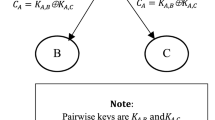Abstract
The broadcast nature of communication channels in infrastructureless wireless networks poses challenges to security. In this paper, we propose a novel technique namely secure multi-channel group key generation (MuGKeG) algorithm. We utilize the available channels switching behaviour between multiple nodes to hide our key from eavesdropper. We provide descriptions for an illustrative base case of three users and one eavesdropper and expand it for the case of N users with C channels and M eavesdroppers. Repeated application of the MuGKeG algorithm on the order of \(O(\log {N})\) allows scaling the size of the group in the order of millions. We provide an analytical closed-form solution for the entropy of the secret group key generated when eavesdroppers follow an optimal attack strategy, and verify it by ns-3 simulations. Comparison with previous state-of-the-art schemes suggests that MuGKeG can provide upto 20 kbps increase in secrecy rate with a scalable key size.





Similar content being viewed by others
References
Arora, A., & Sang, L. (2009). Dialog codes for secure wireless communications. In Proceedings of the IPSN conference.
Basilico, N., Gatti, N., Monga, M., & Sicari, S. (2014). Security games for node localization through verifiable multilateration. IEEE Transactions on Dependable and Secure Computing, 11(1), 72–85.
Cover, T. M., & Thomas, J. A. (2012). Elements of information theory. London: Wiley.
Croft, J., Patwari, N., & Kasera, S. K. (2010). Robust uncorrelated bit extraction methodologies for wireless sensors. In Proceedings of the IPSN conference.
Dong, L., Han, Z., Petropulu, A. P., & Poor, H. V. (2010). Improving wireless physical layer security via cooperating relays. IEEE Transactions on Signal Processing, 58(3), 1875–1888.
Gollakota, S., & Katabi, D. (2011). Physical layer wireless security made fast and channel independent. In Proceedings of the IEEE international conference on computer communications (INFOCOM).
Henderson, T. R., Lacage, M., Riley, G. F., Dowell, C., & Kopena, J. (2008). Network simulations with the ns-3 simulator. In SIGCOMM demonstration.
Hu, C., Cheng, X., Zhang, F., Wu, D., Liao, X., & Chen, D. (2013). OPFKA: Secure and efficient ordered-physiological-feature-based key agreement for wireless body area networks. In Proceedings of the IEEE international conference on computer communications (INFOCOM) (pp. 2274–2282).
Jana, S., Premnath, S. N., Clark, M., Kasera, S. K., Patwari, N., & Krishnamurthy, S. V. (2009). On the effectiveness of secret key extraction from wireless signal strength in real environments. In Proceedings of the ACM MOBICOM conference.
Liu, H., Wang, Y., Yang, J., & Chen, Y. (2013). Fast and practical secret key extraction by exploiting channel response. In Proceedings of the IEEE international conference on computer communications (INFOCOM) (pp. 3048–3056).
Miller, M. J., & Vaidya, N. H. (2006). Leveraging channel diversity for key establishment in wireless sensor networks. In Proceedings of the IEEE international conference on computer communications (INFOCOM).
The Associated Press. (2007). TJX says theft of credit data involved 45.7 million cards. New York: The New York Times.
Safaka, I., Fragouli, C., Argyraki, K., & Diggavi, S. (2012). Creating shared secrets out of thin air. In Proceedings of the 11th ACM workshop on hot topics in networks (pp. 73–78). ACM.
Safaka, I., Fragouli, C., Argyraki, K., & Diggavi, S. (2013). Exchanging pairwise secrets efficiently. In Proceedings of the IEEE international conference on computer communications (INFOCOM) (pp. 2265–2273).
Sankararaman, S., Abu-Affash, K., Efrat, A., Eriksson-Bique, S.D., Polishchuk, V., Ramasubramanian, S., et al. (2012). Optimization schemes for protective jamming. In Proceedings of the ACM international symposium on mobile ad hoc networking and computing (pp. 65–74).
Singh, S. (1999). The code book: The science of secrecy from ancient Egypt to quantum cryptography. Anchor books. EDICION, ISBN 744962333.
Tanenbaum, A. S. (1989). Computer networks (Vol. 1981). Englewood Cliffs, NY: Prentice-Hall.
Tsai, S. C., Tzeng, W. G., & Zhou, K. Y. (2009). Key establishment schemes against storage-bounded adversaries in wireless sensor networks. IEEE Transactions on Wireless Communications, 8, 1218–1222.
Vasudevan, S., Goeckel, D., & Towsley, D. (2010). Security-capacity trade-off in large wireless networks using keyless secrecy. In Proceedings of the eleventh ACM international symposium on mobile ad hoc networking and computing (MobiHoc).
Wang, Q., Su, H., Ren, K., & Kim, K. (2011). Fast and scable secret key generation exploiting channel phase randomness in wireless networks. In Proceedings of the IEEE international conference on computer communications (INFOCOM).
Xiao, S., Gong, W., & Towsley, D. (2010). Secure wireless communication with dynamic secrets. In Proceedings of the IEEE international conference on computer communications (INFOCOM).
Zan, B., & Gruteser, M. (2009). Random channel hopping schemes for key agreement in wireless networks. In IEEE international symposium on personal, indoor and mobile radio communications.
Zhu, X., Xu, F., Novak, E., Tan, C. C., Li, Q., & Chen, G. (2013). Extracting secret key from wireless link dynamics in vehicular environments. In Proceedings of the IEEE international conference on computer communications (INFOCOM) (pp. 2283–2291). IEEE.
Author information
Authors and Affiliations
Corresponding author
Appendix
Rights and permissions
About this article
Cite this article
Ayub, N., Raja, M., Saleh, S. et al. MuGKeG: Secure Multi-channel Group Key Generation Algorithm for Wireless Networks. Wireless Pers Commun 96, 4799–4818 (2017). https://doi.org/10.1007/s11277-017-4423-9
Published:
Issue Date:
DOI: https://doi.org/10.1007/s11277-017-4423-9





